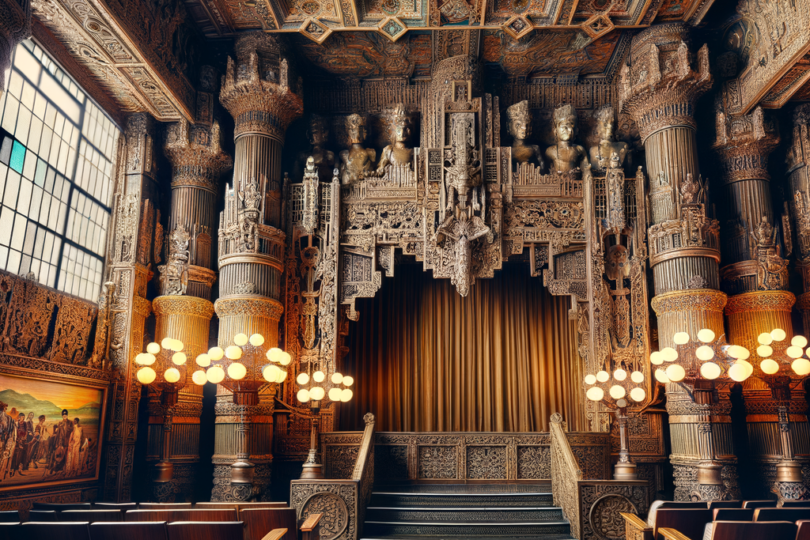Los Angeles has always been synonymous with the silver screen. But beyond the flashing lights and film premieres, the city is home to some of the most iconic, ornate, and historically significant walk-in theaters in the world. These grand venues were more than just places to watch movies—they were cultural landmarks that defined Hollywood’s golden age. In this post, we’ll take you on a tour through the classic movie palaces of LA County, complete with historical context, architectural highlights, and Google Maps links to explore them in real life.
Hollywood’s Glorious Movie Palaces
El Capitan Theatre
- Address: 6838 Hollywood Blvd, Los Angeles, CA
- Opened: 1926
- Style: Spanish Colonial Revival
- Why It Matters: Restored by Disney, El Capitan is a lavish theater still in operation, often used for major Disney movie premieres. Its ornate interior and live organ performances make it a must-see.
- View on Google Maps
Egyptian Theatre
- Address: 6712 Hollywood Blvd, Los Angeles, CA
- Opened: 1922
- Style: Egyptian Revival
- Why It Matters: Designed during the Egyptomania craze, this was Sid Grauman’s first theater and a blueprint for the movie palace era. Now owned by Netflix and American Cinematheque.
- View on Google Maps
TCL Chinese Theatre (Grauman’s Chinese Theatre)
- Address: 6925 Hollywood Blvd, Los Angeles, CA
- Opened: 1927
- Style: Chinese-Inspired Architecture
- Why It Matters: World-famous for its celebrity handprints and star-studded premieres. A symbol of classic Hollywood.
- View on Google Maps
The Vogue Theatre
- Address: 6675 Hollywood Blvd, Los Angeles, CA
- Opened: 1935
- Style: Art Deco
- Why It Matters: Though now repurposed, it still retains its Art Deco elegance. Once a neighborhood favorite for moviegoers.
- View on Google Maps
Avalon Hollywood (formerly Hollywood Palace)
- Address: 1735 Vine St, Los Angeles, CA
- Opened: 1927
- Style: Spanish Colonial Revival
- Why It Matters: This venue evolved from a playhouse to a popular 1960s variety show studio and now functions as a premier nightclub.
- View on Google Maps
Downtown Los Angeles: The Broadway Theater District
Orpheum Theatre
- Address: 842 S Broadway, Los Angeles, CA
- Opened: 1926
- Style: Beaux-Arts
- Why It Matters: Part of a once-bustling theater row, the Orpheum has been lovingly restored and still hosts concerts, screenings, and special events.
- View on Google Maps
Million Dollar Theatre
- Address: 307 S Broadway, Los Angeles, CA
- Opened: 1918
- Style: Spanish Baroque
- Why It Matters: Built by cinema mogul Sid Grauman, this theater was one of the first lavish movie houses in the U.S.
- View on Google Maps
Palace Theatre
- Address: 630 S Broadway, Los Angeles, CA
- Opened: 1911
- Style: Beaux-Arts
- Why It Matters: The oldest remaining Orpheum circuit theater, now preserved as part of LA’s historic core.
Westside & South Bay Gems
Fox Theatre (Westwood Village)
- Address: 961 Broxton Ave, Los Angeles, CA
- Opened: 1931
- Style: Moderne / Streamline
- Why It Matters: Still an active venue for film premieres and one of the best-preserved Art Deco theaters in the country.
- View on Google Maps
The Bijou Theatre (Hermosa Beach)
- Address: 1229 Hermosa Ave, Hermosa Beach, CA (now closed)
- Opened: 1920s
- Style: Spanish Mission Revival
- Why It Matters: A quaint beachside gem remembered fondly by locals. It has since been repurposed, but its charm remains part of Hermosa’s legacy.
Fox Redondo Theatre (Redondo Beach)
- Address: 1801 S Catalina Ave, Redondo Beach, CA
- Opened: 1929
- Style: Art Deco
- Why It Matters: Once a vital entertainment hub in the South Bay. The building remains as a landmark, though no longer operating as a cinema.
- View on Google Maps
Plaza Theater (Hawthorne)
- Address: Near Hawthorne Plaza (Exact address unknown)
- Opened: Mid-20th century
- Why It Matters: Served the community during Hawthorne’s heyday. Long since shuttered, but remembered by generations of locals.
Why These Theaters Still Matter
These architectural marvels are more than relics—they’re living testaments to a time when going to the movies was an event. With domed ceilings, velvet seats, and grand lobbies, each theater tells a story not only about film but about the city itself.
Preserving and visiting these sites keeps the magic alive. Whether you’re a history buff, an architecture lover, or a film fanatic, Los Angeles’ grand theaters offer a unique journey into Hollywood’s past.


